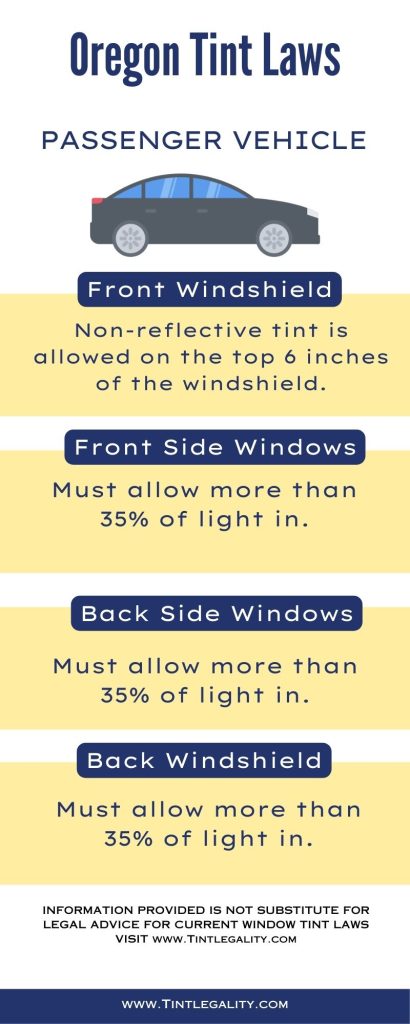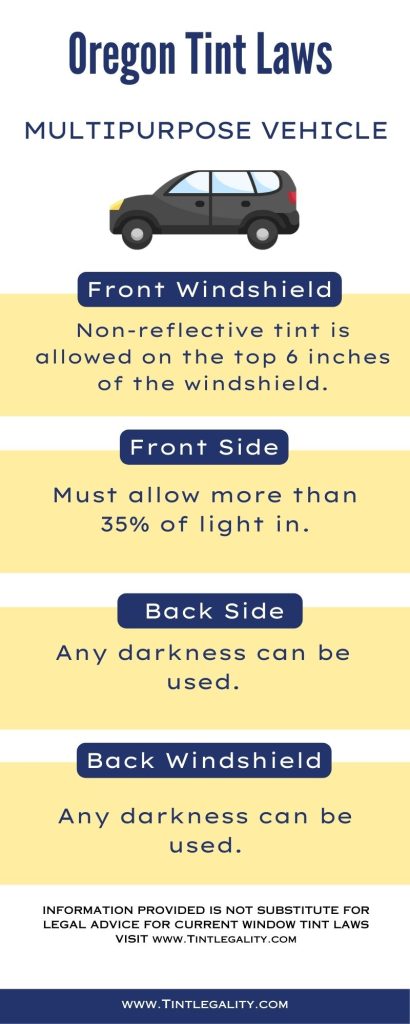Oregon tint laws were enacted in 2003, laying down clear and specific regulations for car window tinting within the state.
As a driver or car owner in Oregon, it’s essential to understand these laws to ensure compliance and avoid fines or penalties.
Regulations Regarding Window Tint in Oregon
When talking about window tint laws, we must mention VLT – Visible Light Transmission.
This percentage indicates how much light the film on the glass allows to pass through.
The specifics differ for various types of vehicles like sedans, SUVs, and vans.
| Car Window | Sedans | SUVs and Vans |
|---|---|---|
| Windshield | Top 6 inches, non-reflective | Top 6 inches, non-reflective |
| Front Side Windows | Must allow more than 35% of light in | Must allow more than 35% of light in |
| Back Side Windows | Must allow more than 35% of light in | Any tint darkness allowed |
| Rear Window | Must allow more than 35% of light in | Any tint darkness allowed |
Windshield
In Oregon, non-reflective tint is permitted on the top 6 inches of the windshield regardless of the vehicle type.
It’s a common specification to prevent obstruction of the driver’s field of view.
Front Side Windows
The laws dictate that front side windows must allow more than 35% light inside the car.
This requirement applies to all vehicle types.
Back Side Windows
Here, the rules differ depending on the vehicle type.
For sedans, the back side windows must also allow more than 35% light inside.
However, for SUVs and vans, any level of darkness can be used.
Rear Window
Again, sedans are required to let over 35% of light through the rear window.
But for SUVs and vans, any tint darkness is permitted.


Additional Regulations
In addition to the VLT requirements, Oregon tint laws include several other regulations.
Reflection
The laws limit how much incoming light your windows can reflect to reduce glare and heat.
For all vehicle types, the front and back side windows must be less than or equal to 13% reflective.
Medical Exemptions
Oregon allows for medical exemptions for darker tints.
If a medical condition requires it, drivers may be permitted to have darker windows than normally allowed.
However, these exceptions need to be legally obtained and recognized.
Color Restrictions
When it comes to the color of your tint, red, gold, yellow, amber, and black tints are prohibited by law.
This regulation is likely to prevent confusion with emergency vehicles and law enforcement.
Side Mirrors
If the window behind the driver is tinted, dual-side mirrors are required by law in Oregon.
Exceptions to Legal Limits
There are a few exceptions to these legal limits.
Tint installers must provide a certificate stating the light transmittance and reflectance.
In addition, a sticker to identify legal tinting is required by law.
Penalties for Breaking the Law
Violating Oregon tint laws can result in severe penalties, including hefty fines. Let’s break them down by conviction:
Fines
First Conviction
Violating the tint laws for the first time is considered a Class B traffic violation in Oregon, and it can result in a fine of up to $360.
Second Conviction
The fine for the second conviction may increase, and the exact amount would be at the discretion of the judge.
Third Conviction
A third conviction would likely result in an even higher fine and potentially other penalties.
Other Penalties
Apart from fines, additional penalties for non-compliance may include being ordered to remove the illegal tint and potential points on your driving record.
Always remember that these tinting laws and regulations may be interpreted differently depending on your county or place of residence.
It’s always recommended to double-check this information with your local DMV or law enforcement authorities.
With its diverse cities, rich history, and beautiful landscapes, Oregon is a state where the rules are just as diverse.
So, keep in mind the Oregon tint laws as you drive around this great state. Stay safe, drive responsibly, and ensure your vehicle is within the state’s tint regulations.
References:
https://en.wikipedia.org/wiki/Oregon
https://www.oregon.gov/Pages/index.aspx
https://www.oregon.gov/odot/dmv/docs/vcb815.pdf
https://www.oregon.gov/ODOT/Safety/Documents/WindowTintBrochure.pdf